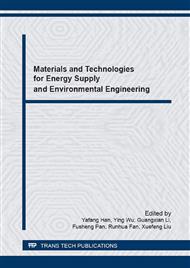p.234
p.241
p.249
p.256
p.265
p.272
p.281
p.287
p.294
Impact of pH Value and Temperature on Cement-Based Materials Adsorbing Heavy Metal Ions
Abstract:
The development of the city traffic and its increasing traffic flux are the signs of the development of the society, but causing a serious pollution on the city's ecological environment. Cement hydration reactions are needed to generate Ca (OH)2, C-S-H gel, and AFt, as well as other hydrated products. Meanwhile, heavy metal ions are contained and fixed in a cement paste under physical encapsulation, absorption, isomorphous replacement, and double decomposition. This paper mainly discusses the impact of hydration environment on the adsorption law of materials adsorbing heavy metal ions and the adsorption mechanism under different pH values and temperatures, analyzing specific reasons from the perspective of micro-structure. Through the analysis it can be seen that, in addition to zinc ions, the cement-based materials’ capacity of adsorbing heavy metal ions increases as the pH value and the temperature increase. Micro-structure analysis shows that cement-based materials’ main adsorption methods are different when pH values are different.
Info:
Periodical:
Pages:
265-271
Citation:
Online since:
March 2016
Authors:
Price:
Сopyright:
© 2016 Trans Tech Publications Ltd. All Rights Reserved
Share:
Citation:


